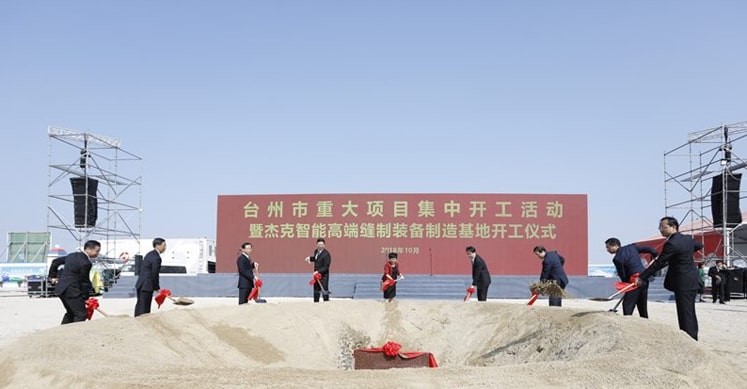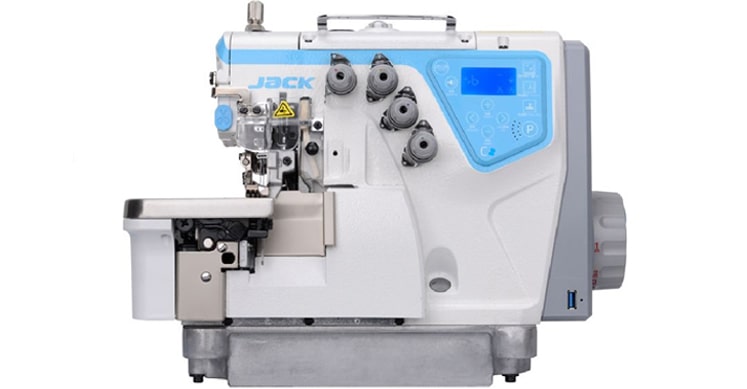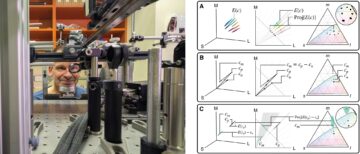Until a decade back, nobody would have imagined that Chinese sewing technology giants will one day take over the European companies, considering the negative perception of the industry. However, defying all perceptions, Jack Sewing Machine Co., Ltd. has acquired top European brands like Bullmer, MAICA and Vibemac in less than a decade and is rapily moving further to become the world’s top manufacturing group of sewing machinery and equipment. Team Apparel Resources, in an exclusive conservation with Ruan Jixiang, Founder of Jack Group, China, found out the growth perspectives of the sewing technology provider.
Having originated in 1995, Chinese sewing machine brand Feiqiu Sewing Machine was renamed as Jack Sewing Machine Co., Ltd. in the year 2000. The idea behind renaming was to step out from the domestic market and enlarge the company’s footprints in the overseas market. It’s a fact that today’s apparel manufacturing giants like India, Bangladesh and Vietnam were in their development phase back then and were getting strong attention from overseas apparel buyers in early 2000 and that’s what Jack sensed. Jack gradually started making its own space in these prominent hubs which were sure to grow bigger with time. With continuous efforts and precise strategies over the years, Jack has emerged as one of the leading sewing machine manufacturers in the world with US $ 330 million turnover in 2018.

AR: First of all, congratulations for Prime Minister’s recent visit to the Jack factory. What were the outcomes of his meeting with you? Do you think his visit will fuel your popularity further?
Ruan: To be honest, ever since we acquired some renowned international companies such as Bullmer, MAICA and Vibemac, a buzz was created in the country which attracted the attention of our Government. PM Li Keqiang came to check our manufacturing unit and his visit shows that the Chinese Government is also supporting private sewing technology companies like Jack in their endeavour to grow even more. Also, the Government knows that we are focusing a lot on intelligent solutions of the sewing machine equipment. PM Li is hopeful that Jack can be an ‘aircraft carrier’ leading the sewing market and we, as Jack team, are geared up by his visit to create more technology innovations so that we can drive our company to new heights in future with the Government support.
Moreover, we have recently been allotted a land by the Chinese Government in Taizhou for our new ‘intelligent’ manufacturing base. So, we are quite hopeful that in the next three to four years, we will be able to become the first company ever to manufacture sewing machines using robots in production lines.
AR: Jack stated last year that it targeted 35% growth in 2018 over 2017. You have already crossed this target in India and other main countries. What are the factors that bolstered this growth?
Ruan: We follow just one mantra: focus on the customers’ demand and sense their need. Firstly, we have those kind of products which the Indian market as well as Bangladesh and Vietnam really demand. We have captured the pain points of the important markets and have solutions to eliminate the challenges end-users face on the sewing floor. We can claim we have the fastest service in the sewing industry right now. India is the biggest market for us with US $ 63 million sales turnover in 2017. We have opened five authorised service centres across all major garment manufacturing hubs of India in the last few years. More than 100 Indian technicians have been trained by us and our own experts are serving the industry today as well. We also provide training to our sub dealers and small level distributors. All such efforts have been highly rewarding for us.

AR: First Bullmer, then MAICA and now Vibemac… China is the world’s largest denim garment production base; therefore, the acquisition of Vibemac will also help Jack to quickly introduce the Italian pioneer in the Chinese market as well as strengthen its position in other Asian countries with Jack’s strong channel advantages. What is your key strategy after this acquisition?
Ruan: In August 2017, I went to India for a few days to check the denim market over there. I saw many big denim factories using Vibemac machines and they are actually producing very fine quality jeans. Vibemac is undoubtedly an excellent company for jeans automation. It’s a fact that the European quality is unbeatable but it is also a fact that it’s expensive and not everyone can afford it. We have a very strong manufacturing base in China; while Vibemac has very strong R&D and high-end technology centre in Italy. We can merge these operations to get advantages on a larger scale and the cost of manufacturing Vibemac jeans automats will surely reduce if the manufacturing base is shifted to China. As a result, Vibemac can see more investment from India and Bangladesh which are price-sensitive markets. I also want to add that Vibemac is not just meant for denims as its machines are also used for manufacturing casual cotton trousers and, needless to say, India and Bangladesh have huge manufacturing set-ups for this product segment.
AR: Jack also tied up with Japanese marketing firm Dentsu last year to expand in overseas markets. Did you see any positive impact of this collaboration?
Ruan: We have got a huge positive feedback from the global industry. Dentsu has helped us in proper branding in the last one year. Jack is a leading company in sewing industry and Dentsu is helping us reach more top garment manufacturing plants across the world. We have expanded a lot in non-traditional markets and consolidated our position in traditional markets with the help of Dentsu. The next step ahead has already been discussed between us and Dentsu and we will now strategise on how we can sell the complete package of Jack, Vibemac, MAICA and Bullmer to the top manufacturers of varied products.
AR: Jack holds a strong position in lockstitch machines but when it comes to chainstitch and knitwear category, we feel it still lacks the kind of expertise which Japanese brands hold. In future, how do you think Jack as a brand will innovate in knitwear segment?
Ruan: I agree with the point made here. Most of the big knitwear factories across the globe use Japanese machines. But, in the last two years, we have worked hard to improve our knitting segment. Now, we have C5 automatic computerised overlock machine which is specially manufactured for knitwear category. Moreover, our famous interlock machine K4 is still a preferred choice in the knitwear market and its upgraded version K5 is also expected to be released soon. We have so many patented technologies in these machines which Japanese brands do not have. Anti-bird nest technology is one of them which greatly enhances the sewing quality.

AR: In last few years Jack has moved from the basic lockstitch machines to automated machines. ‘A’ series is one of them. What other innovations are in pipeline after ‘first thread cleanness machine’ A5? What will be the new developments in the subsequent machines?
Ruan: Every year we release one new product with a new technology in the market. Our second generation lockstitch machine A4 was launched in 2014 and till 2017, we worked a lot to improve its voice feature. In 2017, we launched our third gen lockstitch machine A5 which had just 3.5 mm thread tail that shortened to 3 mm in 2018 and with our continuous development, it will remain at just 2.5 mm in 2019. So all through 2014-2019 period, we planned for more stability in our sewing machines, while from 2019 onwards, we will focus on improving the features of our machines to make sewing more intelligent. The period 2019-2020 will be dedicated to the fourth generation machine A6 which will come with IoT technology, production visualisation and automatic salary accounting system, while the period 2021-2022 will be the fifth generation period when we will focus more on ‘modularity structure’ of the sewing machine. In this structure, stepper motor technology will be integrated.
Moreover, we are soon launching A7 model of SNLS machine which is actually designed and manufactured on the basis of our ISU (Intelligent Sewing Unit) production system. The machine will have four different feeding tracks and it will automatically test the fabric thickness to adjust the presser foot and accordingly, the feed dog. I want to specially mention our IoT technology ‘Integrated Production Management System’ (IPMS) which will be unveiled in A6 model. This software is basically a connector between our vast product portfolio and the information of every machine right from pre-sewing to sewing and then finishing will be stored on cloud. So, we want to assure our customers that we are here to help them keep up with the changing trends in the sewing technology.
AR: You earlier discussed about the Indian market. What strategies is Jack adopting as far as Bangladesh and Vietnam markets are concerned?
Ruan: Most of our products are SNLS machines but the level of technology used in each machine is different and that’s where Jack holds its strength in. After India, Vietnam is the second-most important market for us following Bangladesh. In 2017, we clocked US $ 39 million sales turnover in Vietnam and US $ 17.50 million sales turnover in Bangladesh. Seeing the data, we can say we have to improve our market in Bangladesh though we are growing at a massive rate in the country. We are focusing more on ‘value marketing’ in these countries. Recently, we upgraded our F4 machines to A2/A3 lockstitch machines which come studded with auto trimmers. Simultaneously we are also promoting A5 and A5N machines in the customer segment who are already using A3 and A4 machines and that’s what brings more value to the end-user.
On the other hand, we are keeping an eye on the second hand sewing machine market as well. In the countries mentioned above, second hand machine market is huge and Juki, our competitor, shares a larger chunk of this market. In order to compete with Juki, we are promoting F4 lockstitch machine in the second hand market. We can sense the raging price war in the garment industry and that’s why these kind of strategies are necessary.
Furthermore, we are focusing on ‘less is more’ mantra. We have divided ourselves into three segments: basic business for mid-low level customers; developing business for mid-high level customers; and future business for mid-high level customers. In the first category, we aim to sell basic lockstitch, overlock and interlock machines, while in the second category, we are currently focusing on mid-high level customers and want to provide them all intelligent and automatic solutions according to their needs. However, our future strategy includes selling just intelligent sewing machines to mid-high level customers.
All these strategies are positively working for us and that’s why we have set US $ 60 million sales target for Vietnam in 2019, while Bangladesh has been given a target of US $ 25 million by next year.







